ATHENS
Acropolis
Athena Nike
Erechtheum
Parthenon
Propylaia
Acropolis
Museum
South
Slope overview
South Slope lecture
Pnyx
Areopagus
Philopappos
Hill
Agora
Temple
of Olympian Zeus
and Arch of Hadrian
Keramikos
Roman Agora
ATTICA
Brauron
Thorikos
Sounion
Oropos
Marathon
Eleusis
Aigosthena/
Eleutherai
Daphni
Piraeus
MESSENIA
Pylos
Voidokilia
Methoni
Messene
CORINTHIA
Perachora
Corinth
Acrocorinth
Diolkos/Canal
Nemea
Isthmia
BOEOTIA
Thebes
Chaironeia
Orchomenos
Gla
Osios
Loukas
ARGOLID
Epidavros
Nauplion
Mycenae
Argos
Tiryns
ARCADIA
Megalopolis
Overview
Tegea
LACONIA
Mistras
Sparta
Monemvasia
ACHAEA
Kalavrita
NORTHERN
GREECE
scenery
Mount
Olympos
DELPHI
Thermopylae
Naupaktos
Mieza
Edessa
Vergina
Pella
Thessaloniki
ELEIA
Olympia
Chlemoutsi
SARONIC GULF ISLANDS
Aegina
Poros
Hydra
Spetses
CYCLADIC ISLANDS
Santorini
Delos
CRETE
Cnossos
Phaistos
Zakros
|
 |
Dr.
J's Illustrated Parthenon (built 447-432 BC) Lecture
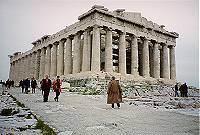 Upon exiting the
Propylaia, the ancient visitor would not have had a clear
view of the Parthenon, as we do today. Now as soon as we leave through the east portico,
we are struck by the full magnificence of the Parthenon (pictured is my mother at the
moment of her first viewing), minus the huge number of statues and smaller structures that
would have positively cluttered the sacred rock in antiquity. Upon exiting the
Propylaia, the ancient visitor would not have had a clear
view of the Parthenon, as we do today. Now as soon as we leave through the east portico,
we are struck by the full magnificence of the Parthenon (pictured is my mother at the
moment of her first viewing), minus the huge number of statues and smaller structures that
would have positively cluttered the sacred rock in antiquity. |
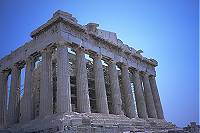 The Parthenon as it has survived is much like the skeletal remains of a
dinosaur - we can only glimpse the full magnificence of what it once was, and yet we are
still awed by its shattered glory. What it must have looked like with its skin and bones
intact! The Parthenon is a traditional peripteral temple (surrounded on all sides by
columns), but built on a grander scale than any temple before it, Pericles' grandest
"imperishable monument" to Athens' greatness: although its outside columns are
arranged in the traditional ratio (X x 2X+1), the Parthenon's columns number 8 x 17 instead
of the average 6 x 13. The Parthenon as it has survived is much like the skeletal remains of a
dinosaur - we can only glimpse the full magnificence of what it once was, and yet we are
still awed by its shattered glory. What it must have looked like with its skin and bones
intact! The Parthenon is a traditional peripteral temple (surrounded on all sides by
columns), but built on a grander scale than any temple before it, Pericles' grandest
"imperishable monument" to Athens' greatness: although its outside columns are
arranged in the traditional ratio (X x 2X+1), the Parthenon's columns number 8 x 17 instead
of the average 6 x 13. |
|
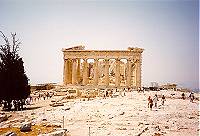 Built between 447-432 BC, the Parthenon has had a long history
of varied uses in its twenty-five hundred year existence: harem quarters for a sultan, a
Christian church, a cathedral, a mosque, and even a bell-tower. Built between 447-432 BC, the Parthenon has had a long history
of varied uses in its twenty-five hundred year existence: harem quarters for a sultan, a
Christian church, a cathedral, a mosque, and even a bell-tower.
|
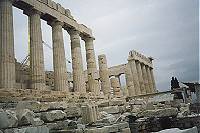 And yet the building had remained
structurally intact until the 17th century. On September 26, 1687 a Venetian shell
exploded the gunpowder stored by the Turks in the cella of the Parthenon. The roof was
blown off and most of the interior cella and its frieze, 6 columns on the South side (all
not yet replaced) and 8 columns on the North side (reconstructed) were obliterated in a
moment's time. And yet the building had remained
structurally intact until the 17th century. On September 26, 1687 a Venetian shell
exploded the gunpowder stored by the Turks in the cella of the Parthenon. The roof was
blown off and most of the interior cella and its frieze, 6 columns on the South side (all
not yet replaced) and 8 columns on the North side (reconstructed) were obliterated in a
moment's time. |
|
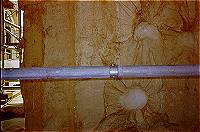 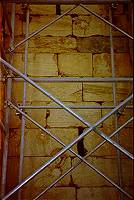 Other less insidious
damage is evident from this war as well: the cannonballs fired by the Venetians from
Philopappos Hill have also left their indelible mark on the marble of the Parthenon. Other less insidious
damage is evident from this war as well: the cannonballs fired by the Venetians from
Philopappos Hill have also left their indelible mark on the marble of the Parthenon.
|
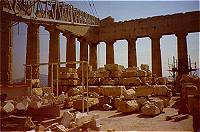 The inside of the temple (naos) appears to be almost
one big room now, but in antiquity it was divided into two separate spaces: the cella
("Hekatompedon", because it was 100 Attic feet in length), and the opisthodomos,
where the state treasury was kept (on the west side). The opisthodomos, or
"back room," was bordered by 4 Ionic columns (taller and slighter than Doric).
The cella was divided by several rows of two-tiered Doric columns, and possibly sported a
second-story viewing area. The grand attraction was Pheidias' 40 foot tall
chryselephantine (gold and ivory) statue of Athena. Pausanias (I.24.5) provides many
details, including The inside of the temple (naos) appears to be almost
one big room now, but in antiquity it was divided into two separate spaces: the cella
("Hekatompedon", because it was 100 Attic feet in length), and the opisthodomos,
where the state treasury was kept (on the west side). The opisthodomos, or
"back room," was bordered by 4 Ionic columns (taller and slighter than Doric).
The cella was divided by several rows of two-tiered Doric columns, and possibly sported a
second-story viewing area. The grand attraction was Pheidias' 40 foot tall
chryselephantine (gold and ivory) statue of Athena. Pausanias (I.24.5) provides many
details, including 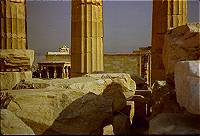 mention of the sphinx and griffins on her helmet. Plutarch (Life of
Pericles) tells us that charges of embezzlement against Pheidias were
dropped when he proved all the gold was there by removing it and weighing it. The statue
was reportedly transported in the 4th century AD to Constantinople and was never seen
again. mention of the sphinx and griffins on her helmet. Plutarch (Life of
Pericles) tells us that charges of embezzlement against Pheidias were
dropped when he proved all the gold was there by removing it and weighing it. The statue
was reportedly transported in the 4th century AD to Constantinople and was never seen
again. |
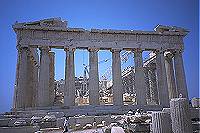 The most glorious aspect of the Parthenon was surely its artwork, all of
which was supervised by the great sculptor Pheidias. Pausanias tells us that the East
pedimental sculpture group (east pedimental area shown in the photo) depicted the Birth of
Athena from her father Zeus' head (I.24.25), but we would not have know that without his
help. The central section - showing the main subject, Athena - is thought to have been
lost when the temple was converted into a church. The most glorious aspect of the Parthenon was surely its artwork, all of
which was supervised by the great sculptor Pheidias. Pausanias tells us that the East
pedimental sculpture group (east pedimental area shown in the photo) depicted the Birth of
Athena from her father Zeus' head (I.24.25), but we would not have know that without his
help. The central section - showing the main subject, Athena - is thought to have been
lost when the temple was converted into a church. |
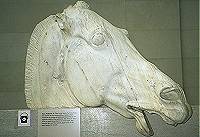 Much of the fabulous
sculpture that has survived from the East pediment is displayed in the British Museum
(some individual pieces are on display in the Acropolis Museum). Here we see the head of
one horse of Selene, exhausted after running his course, now dipping below the horizon as
the sun god Helios' horses rise up from Oceanus to begin the day. Much of the fabulous
sculpture that has survived from the East pediment is displayed in the British Museum
(some individual pieces are on display in the Acropolis Museum). Here we see the head of
one horse of Selene, exhausted after running his course, now dipping below the horizon as
the sun god Helios' horses rise up from Oceanus to begin the day. |
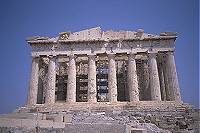 The West pedimental sculpture of the Parthenon depicts the contest for
Attica between Athena and Poseidon. This sculpture group can be reconstructed thanks to
Jacques Carrey's detailed 1674 drawings. Just a few years later, the face of the west
pediment changed forever. Morosini shattered the chariot and horses of Athena in a failed
attempt to remove them, and the pediment suffered untold damage in the bombardment of the
Parthenon during his war against the Turks. The West pedimental sculpture of the Parthenon depicts the contest for
Attica between Athena and Poseidon. This sculpture group can be reconstructed thanks to
Jacques Carrey's detailed 1674 drawings. Just a few years later, the face of the west
pediment changed forever. Morosini shattered the chariot and horses of Athena in a failed
attempt to remove them, and the pediment suffered untold damage in the bombardment of the
Parthenon during his war against the Turks. |
|
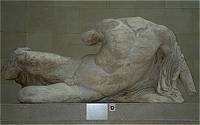 Usually identified as the
river god Illisos, this reclining figure graced the West Pediment. Pedimental corners are
particularly difficult to fill, but this ingenious composition leaves little space unused. Usually identified as the
river god Illisos, this reclining figure graced the West Pediment. Pedimental corners are
particularly difficult to fill, but this ingenious composition leaves little space unused.
|
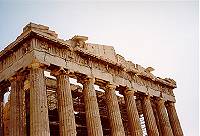 92 metopes covered the four sides of the Parthenon, and they were all
sculpted in high relief (another detail that sets the Parthenon apart from other temples).
On each side of the building is depicted a different conflict, each of which is thought to
allegorize the recent Greek (mostly Athenian) defeat of the Persians: Gigantomachy (east),
Amazonomachy (west, shown in picture), Centauromachy (South) and the Trojan War (north). 92 metopes covered the four sides of the Parthenon, and they were all
sculpted in high relief (another detail that sets the Parthenon apart from other temples).
On each side of the building is depicted a different conflict, each of which is thought to
allegorize the recent Greek (mostly Athenian) defeat of the Persians: Gigantomachy (east),
Amazonomachy (west, shown in picture), Centauromachy (South) and the Trojan War (north). |
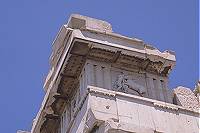 Detail of the remaining SW metope of the Parthenon in situ. A
close-up (below) of this same corner of the Parthenon can be used to illustrate an
architectural peculiarity. Detail of the remaining SW metope of the Parthenon in situ. A
close-up (below) of this same corner of the Parthenon can be used to illustrate an
architectural peculiarity. 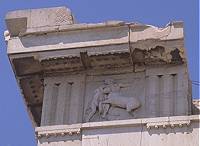 An entire Doric temple can be reconstructed if just the
distance from one gutta (they look like
drip marks - perhaps modeled after water dripping from older wooden temples???) to the
next is known: the six guttae are equally distributed on the regula, which is the same
width as a triglyph, which is 2/3 the size of a metope... An entire Doric temple can be reconstructed if just the
distance from one gutta (they look like
drip marks - perhaps modeled after water dripping from older wooden temples???) to the
next is known: the six guttae are equally distributed on the regula, which is the same
width as a triglyph, which is 2/3 the size of a metope... |
|
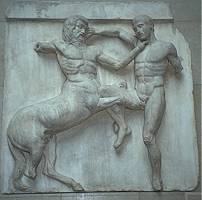
The metopes on the south
side of the Parthenon are in the best shape of all. Lord Elgin brought 14 south metopes to
the British Museum in the early nineteenth century, where they can be seen today.
Go to Dr.
J's Illustrated Parthenon Marbles for photos of all the
metopes.
|
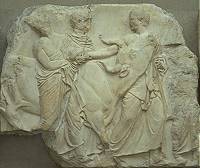 And, of course, there is the
famous Parthenon frieze, one continuous band of sculpture 160 meters long depicting the
Panathenaic Procession that bordered the top of the entire interior of the temple. The
culminating moment is the delivery of the sacred peplos to Athena, which every four years
was draped over her olive-wood statue in the Erechtheum. Much of the frieze was destroyed
in the 1687 explosion, but about one-half is in the British Museum today, while various
pieces survive elsewhere (some original slabs are even in situ on the Parthenon
today). This slab is the inspiration for Keats' "heifer lowing at the skies" in
his Ode on a Grecian Urn. And, of course, there is the
famous Parthenon frieze, one continuous band of sculpture 160 meters long depicting the
Panathenaic Procession that bordered the top of the entire interior of the temple. The
culminating moment is the delivery of the sacred peplos to Athena, which every four years
was draped over her olive-wood statue in the Erechtheum. Much of the frieze was destroyed
in the 1687 explosion, but about one-half is in the British Museum today, while various
pieces survive elsewhere (some original slabs are even in situ on the Parthenon
today). This slab is the inspiration for Keats' "heifer lowing at the skies" in
his Ode on a Grecian Urn. |
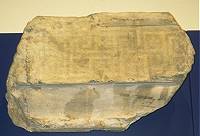 Nor was the temple white, as many incorrectly think. This chunk shows clear
remnants of a painted design. The hyperlink shows a display in the British Museum that
reconstructs the border above the frieze in its true brightly colored appearance, as
based on this model. By our standards, the Parthenon would have looked positively garish! Nor was the temple white, as many incorrectly think. This chunk shows clear
remnants of a painted design. The hyperlink shows a display in the British Museum that
reconstructs the border above the frieze in its true brightly colored appearance, as
based on this model. By our standards, the Parthenon would have looked positively garish! |
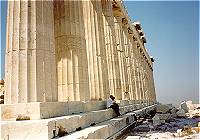 View of the Northern side of the Parthenon. Although the building appears
perfectly rectilinear from afar, the architect Ictinus used several design tricks to
create what is in fact a brilliant optical illusion. One of these tricks is called entasis,
the bulge in the stylobate (foundation on which the columns stand). Proof of entasis is
that the Parthenon fails the "hat test": a hat left on one end of the stylobate
cannot be seen from the other end if you crouch down and view it from ground level. The
entasis of the Parthenon's stylobate is clearly visible in this close-up. View of the Northern side of the Parthenon. Although the building appears
perfectly rectilinear from afar, the architect Ictinus used several design tricks to
create what is in fact a brilliant optical illusion. One of these tricks is called entasis,
the bulge in the stylobate (foundation on which the columns stand). Proof of entasis is
that the Parthenon fails the "hat test": a hat left on one end of the stylobate
cannot be seen from the other end if you crouch down and view it from ground level. The
entasis of the Parthenon's stylobate is clearly visible in this close-up. |
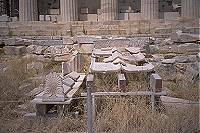 Display of Parthenon akroteria (end roof pieces) and interlocking
marble rooftile pieces. The Parthenon was unique in Greek architecture because it was the
only structure made completely of marble, including the roof. (The roof of the inner cella
had a wooden structure under the marble, and the first three courses of the building -
hidden underground - were made of limestone). Display of Parthenon akroteria (end roof pieces) and interlocking
marble rooftile pieces. The Parthenon was unique in Greek architecture because it was the
only structure made completely of marble, including the roof. (The roof of the inner cella
had a wooden structure under the marble, and the first three courses of the building -
hidden underground - were made of limestone). |
   This
unused column drum, intended for use in the pre-Persian invasion version of the Parthenon,
is about 5 feet in diameter... although not ready for production, this drum has undergone
some of the three part fluting process: rough quarry fluting, workshop finish, and final
finish. To the right is original carved set mark for placement of Parthenon column drum. This
unused column drum, intended for use in the pre-Persian invasion version of the Parthenon,
is about 5 feet in diameter... although not ready for production, this drum has undergone
some of the three part fluting process: rough quarry fluting, workshop finish, and final
finish. To the right is original carved set mark for placement of Parthenon column drum. |
Kyoto Institute's
computer-generated reconstruction of NW corner of the Parthenon
Parthenon of Nashville: Virtual
tour of the entire guilding including pedimental sculpture and statue of Athena Parthenos
Parthenon Reconstruction Project
in Athens
Ann Nicgorski's Parthenon page: http://www.willamette.edu/cla/wviews/parthenon/
The Parthenon:
informational, like mine, but from Reed College
|























